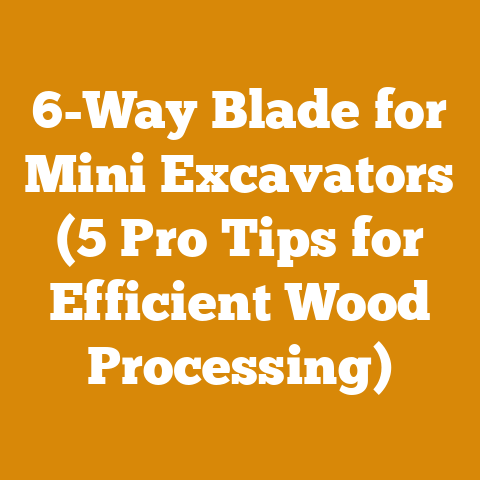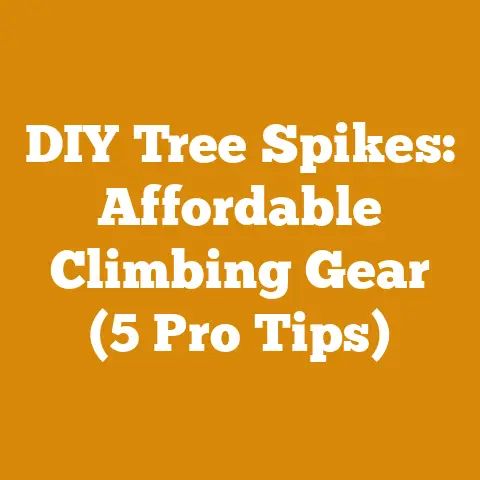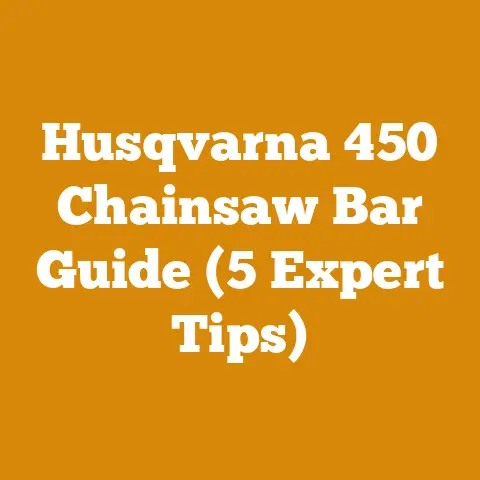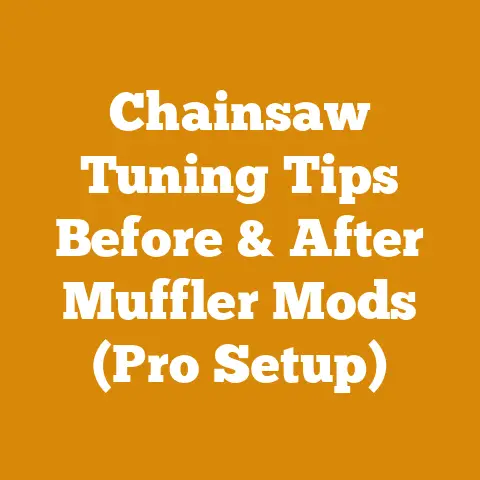How to Remove Shrubs and Bushes (5 Proven Wood Processing Hacks)
Hello fellow wood enthusiasts!
Understanding the Task: Why Remove Shrubs and Bushes?
Before diving into the “how,” let’s quickly address the “why.” I’ve encountered countless situations where removing shrubs and bushes was essential. Sometimes, it’s for aesthetic reasons, like overgrown bushes blocking sunlight or creating an unkempt appearance. Other times, it’s a matter of safety – thorny bushes near walkways can be a hazard. And of course, there are practical reasons, such as preparing land for building or agriculture.
No matter the reason, it’s important to consider the ecological impact. Shrubs and bushes provide habitat for wildlife, prevent soil erosion, and contribute to the overall biodiversity of an area. Therefore, I always advocate for responsible removal, which includes replanting native species or utilizing the removed vegetation in a sustainable way.
Hack #1: The Right Tools for the Job
Having the right tools is crucial for efficient and safe shrub and bush removal. Over the years, I’ve learned that investing in quality tools pays off in the long run, saving time, effort, and potential injuries. Here’s my essential toolkit:
- Chainsaw: For larger shrubs and bushes with thick trunks, a chainsaw is indispensable. I personally use a 16-inch Stihl MS 271 Farm Boss, which provides a good balance of power and maneuverability. For smaller jobs, a battery-powered chainsaw like the Stihl MSA 161 T can be a great option.
- Loppers: These long-handled pruning shears are perfect for cutting branches up to 2 inches in diameter. I recommend loppers with compound action, which provides greater cutting power with less effort.
- Pruning Shears (Hand Pruners): For smaller branches and stems, a good pair of hand pruners is essential. Look for bypass pruners, which make cleaner cuts than anvil pruners.
- Shovel: A sturdy shovel is needed for digging around the roots of the shrubs and bushes. I prefer a spade shovel with a pointed blade for easier penetration into the soil.
- Pickaxe or Mattock: For larger shrubs and bushes with extensive root systems, a pickaxe or mattock can be invaluable for breaking up the soil and severing roots.
- Gloves: Protect your hands from thorns, splinters, and blisters with a good pair of work gloves. I prefer leather gloves with reinforced palms for added durability.
- Safety Glasses: Eye protection is non-negotiable when using power tools or working with sharp objects.
- Hearing Protection: Chainsaws can be incredibly loud, so always wear earplugs or earmuffs to protect your hearing.
- Work Boots: Sturdy work boots with good ankle support are essential for preventing injuries.
- First Aid Kit: Keep a well-stocked first aid kit on hand for treating minor cuts and scrapes.
Tool Maintenance:
I can’t stress enough the importance of proper tool maintenance. A sharp chainsaw is a safe chainsaw. Regularly sharpen your chainsaw chain and check the bar for wear. Clean and oil your loppers and pruning shears after each use to prevent rust and corrosion. Store your tools in a dry place to prolong their lifespan.
Hack #2: Assessing the Situation and Planning Your Attack
Before you start hacking away, take some time to assess the situation. Consider the size and type of shrubs and bushes you’re dealing with, the location of underground utilities, and any potential hazards in the area.
Identifying Shrubs and Bushes:
Knowing the type of shrub or bush you’re dealing with can help you determine the best removal method. Some shrubs have shallow, easily removable root systems, while others have deep, tenacious roots that require more effort.
Locating Underground Utilities:
Before you start digging, it’s crucial to locate any underground utilities in the area. Contact your local utility companies to mark the location of buried lines. Digging near unmarked utilities can be extremely dangerous and can result in costly repairs.
Identifying Potential Hazards:
Look for potential hazards such as poison ivy, stinging nettles, or sharp objects hidden within the shrubs and bushes. Wear appropriate protective clothing and take precautions to avoid contact with these hazards.
Planning Your Approach:
Once you’ve assessed the situation, develop a plan of attack. Decide which shrubs and bushes need to be removed and which ones can be pruned or transplanted. Determine the best method for removing each shrub or bush based on its size, type, and location.
Hack #3: Cutting Back the Top Growth
The first step in removing shrubs and bushes is to cut back the top growth. This makes it easier to access the root system and reduces the amount of debris you have to deal with.
Using Loppers and Pruning Shears:
Start by using loppers and pruning shears to remove any small branches and stems. Cut the branches back to the main trunk or stem, making clean, angled cuts.
Using a Chainsaw:
For larger shrubs and bushes with thick trunks, use a chainsaw to cut the main stems close to the ground. Be careful to avoid cutting into the ground, as this can damage your chainsaw chain.
Safety First:
When using a chainsaw, always wear appropriate safety gear, including safety glasses, hearing protection, and work gloves. Maintain a firm grip on the chainsaw and keep your body balanced. Never cut above shoulder height or reach across your body to make a cut.
Disposing of the Top Growth:
Once you’ve cut back the top growth, you have several options for disposal. You can chip the branches and use them as mulch, compost them, or haul them away to a local yard waste facility.
Hack #4: Exposing and Severing the Root System
With the top growth removed, the next step is to expose and sever the root system. This is often the most challenging part of the process, especially for shrubs and bushes with extensive root systems.
Digging Around the Base:
Use a shovel to dig around the base of the shrub or bush, exposing the main roots. Dig down at least 12 inches, or deeper if the root system appears to be extensive.
Using a Pickaxe or Mattock:
If the soil is hard or compacted, use a pickaxe or mattock to break it up. This will make it easier to dig around the roots.
Severing the Roots:
Once you’ve exposed the roots, use loppers, pruning shears, or a saw to sever them. Cut the roots as close to the main trunk as possible. For larger roots, you may need to use a chainsaw.
Leveraging Techniques:
For larger shrubs and bushes, you may need to use leverage to help dislodge the root system. Insert a pry bar or shovel under the base of the trunk and use it to lift the shrub or bush out of the ground.
Hack #5: Removing the Root Ball and Preparing the Site
After severing the roots, the final step is to remove the root ball and prepare the site for replanting or other landscaping.
Pulling Out the Root Ball:
With the roots severed, you should be able to pull the root ball out of the ground. If the root ball is too heavy to lift, you may need to use a come-along or winch to pull it out.
Removing Remaining Roots:
Once you’ve removed the root ball, check the surrounding soil for any remaining roots. Remove these roots to prevent the shrub or bush from growing back.
Filling the Hole:
Fill the hole with topsoil and compost to create a healthy growing environment for new plants.
Grading the Site:
Grade the site to ensure proper drainage and prevent water from pooling around the planting area.
Replanting or Landscaping:
Once the site is prepared, you can replant with new shrubs or bushes, install a lawn, or create a garden.
Bonus Hack: Turning Waste into Resource
Don’t let those removed shrubs and bushes go to waste. I always try to find ways to repurpose the materials.
Making Firewood:
If the shrubs and bushes are a suitable hardwood species, you can cut them into firewood. Season the wood for at least six months before burning it.
Creating Mulch:
Chip the branches and stems and use them as mulch around your garden or landscape. Mulch helps to retain moisture in the soil, suppress weeds, and add nutrients to the soil as it decomposes.
Composting:
Compost the leaves and small branches to create a nutrient-rich soil amendment for your garden.
Building a Brush Pile:
Create a brush pile in a secluded area of your property to provide habitat for wildlife. Brush piles provide shelter and nesting sites for birds, small mammals, and insects.
Safety Considerations
Safety should always be your top priority when removing shrubs and bushes. Here are some important safety considerations:
- Wear appropriate safety gear: Always wear safety glasses, hearing protection, work gloves, and sturdy work boots when using power tools or working with sharp objects.
- Be aware of your surroundings: Watch out for potential hazards such as poison ivy, stinging nettles, and sharp objects.
- Use caution when using power tools: Follow the manufacturer’s instructions for operating power tools safely. Never use a chainsaw or other power tool if you are tired or under the influence of drugs or alcohol.
- Call before you dig: Contact your local utility companies to mark the location of buried lines before you start digging.
- Work with a partner: If possible, work with a partner when removing shrubs and bushes. This can make the job easier and safer.
- Take breaks: Don’t try to do too much at once. Take breaks to avoid fatigue and prevent injuries.
- Know your limits: If you’re not comfortable using a particular tool or performing a specific task, don’t do it. Hire a professional to do the job for you.
- Stay hydrated: Drink plenty of water to stay hydrated, especially when working in hot weather.
- Be prepared for emergencies: Keep a well-stocked first aid kit on hand and know how to use it. Have a plan in place for dealing with emergencies.
Conclusion
Removing shrubs and bushes can be a challenging but rewarding task. By following these proven wood processing hacks, you can efficiently and safely remove unwanted vegetation and transform it into useful resources. Remember to always prioritize safety and to consider the ecological impact of your actions.
With the right tools, a well-thought-out plan, and a little elbow grease, you can successfully remove shrubs and bushes and create a beautiful and sustainable landscape. And who knows, you might even discover a new passion for wood processing along the way!






